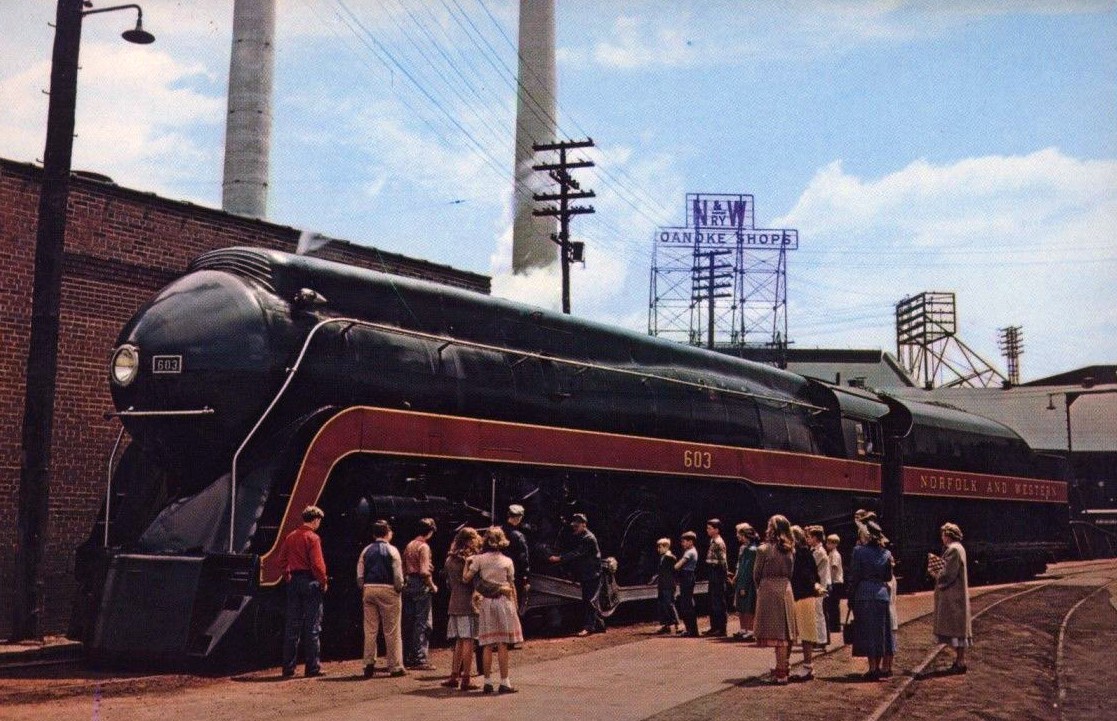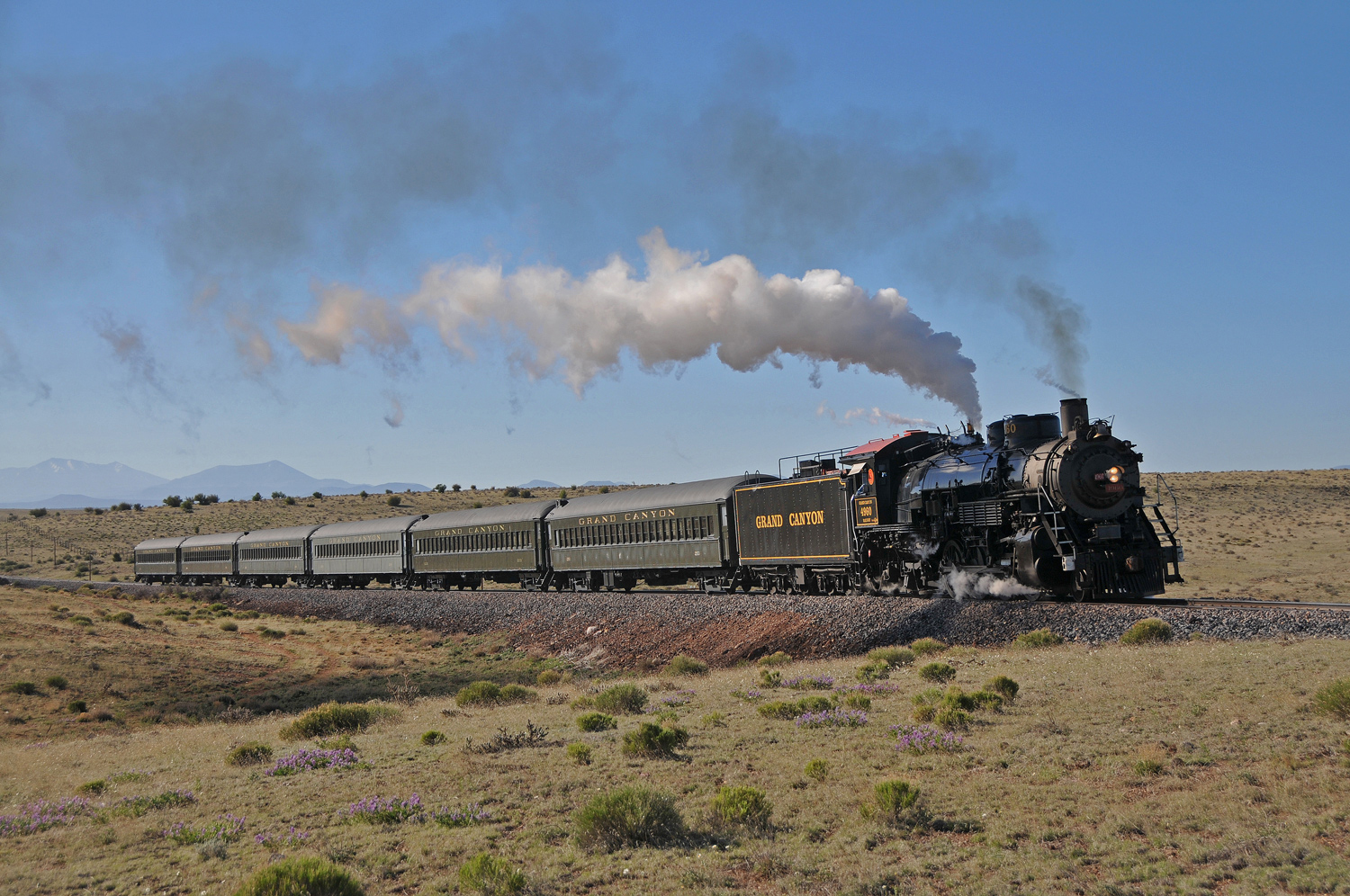N&W's 4-8-4 Locomotives (Class J): Specs, Roster, History
Published: March 26, 2025
By: Adam Burns
One of the most powerful locomotive classes ever built was the Norfolk & Western's fleet of home-built 4-8-4's. These machines not only carried an elegant, beautiful streamlining but were also very fast, capable of speeds approaching 100 mph!
The N&W were master steam builders, arguably better than the commercial manufacturers, and outshopped more than a dozen 4-8-4's over a decade's period. The J's handled all of the railroad's top trains, notably the Powhatan Arrow and Pocahontas, but also occasionally found themselves in freight assignments.
More than any other railroad the N&W was fiercely dedicated to steam technology and had the secondary steam market not collapsed probably would have continued running the motive power into at least the 1960s. Today, #611 survives and is operational.
The Norfolk & Western did not boast an expansive passenger fleet, even during the streamliner age. Interestingly, the railroad worked in conjunction nearly as much with other systems in moving their trains as it did its own.
The N&W's three top services included the Cavalier, Pocahontas, and Powhatan Arrow (inaugurated after World War II) all of which served Norfolk and Cincinnati/Columbus, the primary end-to-end cities it served.
 A Norfolk & Western publicity photo featuring one of the railroad's beautiful 4-8-4's, #603 (J), on display where she was built, at the Roanoke Shops circa 1940s.
A Norfolk & Western publicity photo featuring one of the railroad's beautiful 4-8-4's, #603 (J), on display where she was built, at the Roanoke Shops circa 1940s.History
The railroad was also not particularly enamored with the streamliner concept, waiting until after the war to launch its first (the Arrow). Despite this, the company went on to build arguably the best 4-8-4 design ever put into service, the J Class.
As Thomas Dixon, Jr. notes in his book, "Norfolk & Western Steam: The Last 30 Years," the N&W did not give names to its steam classes (such as Northern, Pacific, Mountain, etc.). Instead, it simply referred to them by their class letter; J, Z, A, Y, etc.
The 4-8-4's were given Class J and built by the master steam builders at N&W's Roanoke, Virginia shops. These machines could haul the mail, quite literally, and were the most powerful 4-8-4's ever built with tractive efforts reaching 80,000 pounds, boiler pressures of 300 psi, and perfectly couter-balanced to reach unimaginable speeds of 140 mph!
It is not believed the J's ever reached such speeds, even during testing, but if so would have achieved world records as the fastest steam locomotives ever built.
The current world record holder (125.88 mph) is the British-built Class A-4 "Mallard," a 4-6-2 Pacific-type (#4468) operated on the London & North Eastern Railway while the Milwaukee Road's Class A Atlantics and Class F-7 Hudsons were the fastest in the States, commonly eclipsing 100 mph ahead of the "Hiawathas" of the 1930s.
The J's predated the Arrow as the first example of streamlining employed by the N&W. Until they were built the railroad had relied on 4-8-2 Mountains (K Class) to power their premier passenger services while a combination of smaller designs (4-6-2's, 4-4-2's, and 4-6-0's) handled other assignments.
With surging demand and an aging fleet of locomotives the N&W needed something more powerful. Typical of company practice the N&W went its own way, designing a custom 4-8-4 "Northern" type after studying those in service on nearby Richmond, Fredericksburg & Potomac and Chesapeake & Ohio.
With the rise of streamliners just prior to World War II the company elected to shroud its new 4-8-4's. In the process it took delivery of some streamlined coaches, intended to be used throughout the N&W system in conjunction with modernized heavyweight diners and lounges.
The first five J's were numbered 600-604, carried 70-inch drivers, and offered 73,500 pounds of tractive effort (boiler pressure reached 275 psi).
As a late-era design they sported some of the best technology of the times such as a feedwater heater (Worthington Type G5-A) for higher water temperatures and an automatic stoker (Standard Type HT).
In addition the J's were equipped with more Timken roller bearings (greatly reducing wear on moving parts) than any other locomotive; they were added to all axles, main and side rods, valve gear, and wrist pins.
Finally, there was the streamlining. Some railroads worked with manufacturers or hired industrial designers to provide the locomotive with an eye-catching look and invoke the appearance of speed, even while stationary.
However, again going its own way, the N&W kept this work in-house turning to its own Frank C. Noel of the railroad's passenger car department. He came up with a design that was somewhat similar to the Milwaukee Road's streamlined Atlantics and Hudsons in that the shrouding generally followed the natural lines of the locomotive.
Overall, the J's carried a bullet-like appearance with skirting along the running-board which was painted Tuscan Red adorned in gold-leaf pinstriping and lettering. The rest of the locomotive was standard black. It was a rather simple, yet very elegant, look.
The company wasted no time in featuring its new 4-8-4's in promotional material and advertisements (especially after the war), drawing wide acclaim and celebrity for the J's, which carries through to this day. While the J's have been revered for their good looks their mechanical might has made them just as legendary.
Roster
The "J" Class
| Class | Road Numbers | Date Built | Builder | Quantity |
|---|---|---|---|---|
| J | 600-604 | 1941-1942 | N&W | 5 |
| J-1 | 605-610 | 1943-1944 | N&W | 6 |
| J-1 | 611-613 | 1950 | N&W | 3 |
Aside from their power the N&W went far beyond the major manufacturers, and various railroads' own custom-built designs, to produce a state-of-the-art locomotive.
Mr. Dixon notes the J's were equipped with Nathan engine oil lubricators, which automatically lubricated 208 points on the locomotive as well as a valve lubricator to automatically grease valves, pistons, and other important components. There were also pressure grease fittings offering yet another means of lubrication for vital parts.
Such details not only decreased wear but also increased their service periods, allowing the J's to go 15,000 miles, or about 18 months, between major overhauls. The initial J's entered service between October of 1941 and January of 1942, assigned to the Cavalier and Pocahontas.
They were joined by six others in 1943, listed as Class J-1 and numbered 605-610. The N&W was not allowed to build these variants to the same high standards (including streamlining and lighter components) because of wartime restrictions.
As a result, they were largely used for freight service, a task at which they were also quite capable thanks to their smaller drivers and high tractive effort. In 1946 the N&W launched the first postwar streamliner when it debuted the all-coach Powhatan Arrow between Norfolk and Cincinnati.
The J's were normal power this train. At this time the railroad also overhauled #605-610 with streamlining and upgrades to match #600-604. With demand still high in the postwar years the N&W elected to build three more 4-8-4's, #611-613, which proved the most powerful of the fourteen offering 80,000 pounds of tractive effort and boiler pressures of 300 psi.
At around the same time the railroad upgraded the other eleven to similar specifications. For the next eight years the J's continued handling N&W's top trains, and also powered a number of Southern's trains between Lynchburg, Virginia and Bristol, Virginia/Tennessee (including the Tennessean, Pelican, and Birmingham Special). Alas, their fall from grace was swift.
When the N&W gave up on steam in 1958 they were quickly pulled from the roster while a few carried on in local freight service. All but one of the fourteen J's were retired and scrapped between October of 1958 and August of 1959.
 Norfolk & Western 4-8-4 #611 (J) drifts downgrade from Montgomery, Virginia with the "Pelican" on the late afternoon of May 8, 2016. Jon Wright photo.
Norfolk & Western 4-8-4 #611 (J) drifts downgrade from Montgomery, Virginia with the "Pelican" on the late afternoon of May 8, 2016. Jon Wright photo.Thankfully, #611 was saved and donated to the city of Roanoke where it was put on display at the Virginia Museum of Transportation. It found new life in 1981 after restoration saw the unit pulling excursions on Norfolk Southern's steam program for more than a decade.
It was then retired again in 1994, making its last run on December 7th, following the end of the steam program. In 2011 NS brought back its program and whispering soon began regarding the possible restoration of #611.
That dream came closer on February 22, 2013 when the Virginia Museum of Transportation announced it had created the Fire Up 611 Committee to launch a feasibility study looking at potentially operating the locomotive once more.
The ultimate decision was a resounding "yes!" and #611 was rebuilt and returned to service in 2015. Soon after this occurred Norfolk Southern ended their steam program for a second time. However, the big 4-8-4 continues to host excursions at various venues each year.
Recent Articles
-
Florida Railroad Museums: A Complete Guide
Apr 17, 25 04:48 PM
Florida is home to many railroad museums preserving the state's rail heritage, including an organization detailing the great Overseas Railroad. -
Delaware Railroad Museums: A Complete Guide
Apr 17, 25 04:23 PM
Delaware may rank 49th in state size but has a long history with trains. Today, a few museums dot the region. -
Arizona Railroad Museums: A Complete Guide
Apr 16, 25 01:17 PM
Learn about Arizona's rich history with railroads at one of several museums scattered throughout the state. More information about these organizations may be found here.
